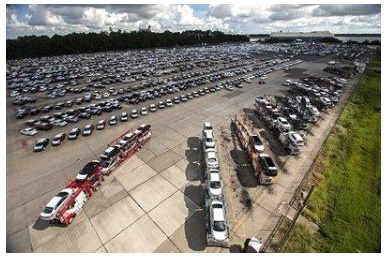Facility Expansion: Brunswick, New York/New Jersey
![]() Print this Article | Send to Colleague
Print this Article | Send to Colleague
At the annual Brunswick State of the Port event on October 20, Georgia Ports Authority Executive Director Curtis Foltz discussed an ambitious capital improvement plan for Brunswick terminals.
"In order to ensure efficient processing of cargo, our capacity must remain higher than current demand," Mr. Foltz said. "To that end, we will be improving Brunswick facilities serving each of our major business sectors here, including automotive, break bulk and bulk cargo."
He noted that during the past decade, the GPA has spent $46.2 million on infrastructure upgrades at the Port of Brunswick. Over the next 10 years, the authority plans to more than triple that investment, calling for another $152 million in improvements.
Among other things, the GPA intends to add a fourth berth to serve roll-on/roll-off cargo at Colonel's Island Terminal. The GPA has submitted a permit request to the U.S. Army Corps of Engineers for the new berth, and hopes to begin construction in 2016.
Currently served by eight ocean carriers, Colonel's Island Terminal offers three ro/ro berths and four on-terminal auto processors and handles cargo for more than 60 auto and heavy machinery manufacturers. With, 696 acres are in use and 641 acres are permitted for expansion on Colonel's Island, GPA can easily accommodate additional ro/ro business."
The GPA is currently preparing 40 acres on the south side of Colonel's Island to be pad ready for new port customers. The U.S. Southeast is the fastest growing consumer market for autos.
Fiscal Year 2016 projects include additional earthwork on the south side of Colonel's Island, the next phase of the Anguilla Junction Rail Yard expansion, the first phase of a berth upgrade at Mayor's Point, East River Terminal improvements and continued upgrades at the Colonel's Island agribulk facility.
At Anguilla Junction, the GPA is funding the addition of 8,470 feet of track, a 28 percent increase, to provide a total of 39,039 feet of track. The rail yard is being improved to better handle export automobiles built in Alabama, Tennessee and Indiana.
"Another important infrastructure improvement is the maintenance dredging that must be funded by the federal government," said GPA Chairman James Walters. "While the president has included $5.8 million in his budget proposal for FY2016, Congress has yet to pass an Energy and Water Appropriations Bill at this time. Securing sufficient funding for Brunswick harbor maintenance is our top priority right now."

The Port of Brunswick moved 680,414 cars, trucks and tractors in Fiscal Year 2015. The Georgia Ports Authority plans investments in the port totaling $152 million over the next decade.
Photo/Georgia Ports Authority
New York/New Jersey Port Authority Board Approves Agreement to Allow For Construction of Express Rail Port Jersey Facility
An agreement that will allow construction to proceed on a ship-to-rail facility adjacent to GCT Bayonne was approved October 22 by the board of commissioners of the Port Authority of New York & New Jersey. The project completes the agency's $600 million initiative to provide all of its major marine terminals with direct access to rail.
Under a lease supplement with GCT USA, the terminal operator agreed to complete the final design and build the new ExpressRail Port Jersey facility in Greenville Yard. In return, the port authority will reimburse GCT up to $56 million to cover the costs of construction of the facility. The project, as with other ExpressRail projects in the harbor, is contingent on continued funding provided by the Cargo Facility Charge, a per-container fee assessed on cargo shipped through the Port of New York and New Jersey to cover the costs of critical road, rail and security infrastructure projects.
Once the ExpressRail facility opens in 2018, GCT will be responsible for the ongoing operation and maintenance of the facility, which is expected to reduce truck traffic and result in significant environmental benefits for the region.
During its lifetime, the ExpressRail Port Jersey facility is expected to reduce nitrogen oxide emissions by 415 tons and particulate matter emissions by 108 tons, which is the equivalent to taking more than 45,300 cars off the road. The facility also will reduce carbon dioxide emissions by 331,161 tons, which equates to the carbon emissions from 30,215 homes.
Cargo coming on and off ships at GCT Bayonne today is transported to and from its final destination by truck or by truck to another ExpressRail facility. The new facility will allow the transloading of containerized cargo from ship to rail, with an initial capacity of at least 125,000 container lifts a year.
Global also plans to launch a truck appointment system later this year to help reduce congestion and improve efficiency at its facility. Creating a truck appointment system at all of the port authority's marine terminals was a top recommendation by the Port Performance Task Force.
The port authority reports record container movements through its facilities, with volume for the year through August up 12.9 percent from a year ago to nearly 4.3 million TEUs.

